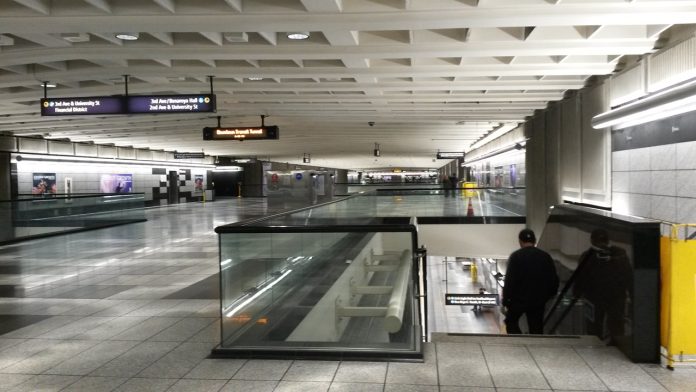On Thursday, the Sound Transit Board of Directors met to decide on the fate of a light rail station’s name. University Street Station, they decided, will become Union Street/Symphony Station in 2021 when the Northgate light rail extension opens. This decision comes on the heels of an extensive public process in shortlisting a new name where a plurality of the surveyed public supported a simpler version: Symphony Station. The last-minute expanded name change came at the behest of technical agency staff, but the decision ultimately is reflective of a tortured and inconsistent facility naming process, despite supposedly being grounded in formal policy guidance.
Some may reasonably ask what the point of public input is in facility naming contests when agency staff and policymakers simply overlook the will of the public and policy guidance.
To be fair, agency staff had explained that should a station name be selected without the University Street Station “USS” acronym, implementation costs could have been nearly $5.3 million instead of the $1.05 million that Union Street/Symphony Station will cost. That is because backend systems would have needed heavy programming changes to switch codes and naming relationships, agency staff said. Had Sound Transit kept the “USS” codes but changed the name without following that letter convention, agency staff also said it could create confusion for emergency professionals familiar with the code. Those are indeed problems worth weighing.
A Sound Transit boardmember, Paul Roberts, had suggested at last week’s committee meeting that “Union Street/Symphony Station” would “be a great name for a rock band.” However, that is not what the public was asked to weigh in on in the fall. When the public was surveyed, nearly a quarter supported the Symphony option compared to five other options on the table (i.e., Arts District, Benaroya Hall, Downtown Arts District, Midtown, and Seneca Street), none of which included the clunky “Union Street” prefix.
Had Sound Transit come out with the prefix or “USS” acronym requirements earlier in the process, this could have at least not wasted everyone’s time with options that never had a chance and public opinion may have been quite different. Indeed, Sound Transit spokesperson David Jackson confirmed that the survey and technical analysis processes for station naming were happening at the same time but separately. “Had we realized the extent of the back-end work required for any acronym not USS, the survey choices would have been different,” he said.
The whole reason Sound Transit engaged in the process to rename University Street Station was to avoid confusion with two other “university” stations, one of which is open (University of Washington) and another that will debut with the Northgate light rail extension (U District). But University Street Station does not sit below or have direct access to Union Street. A “Union Station” already exists in Seattle–which could find reactivation for transit in the years to come–as well as a Tacoma Link stop named “Union Station”. Renaming University Street Station with “Union Street” itself adds confusion to the system. Why bother engaging in a process to reduce confusion only to add more confusion?
The case of Union Street/Symphony Station is not an isolated problem with Sound Transit’s increasingly problematic and poorly implemented facility naming policy, which may as well have just been sitting on the shelf gathering dust since its adoption in 2012.
Last fall, Sound Transit ran into trouble when it rolled out the use of color-based naming of light rail lines. Central Link became the Red Line, which evoked concern about the name’s association with the historic practice of redlining. Several communities served by the line were explicitly redlined in the 20th Century. The naming convention itself came from strict adherence to the facility naming policy. However, the transit agency has stopped use of the Red Line name and reverted back to Central Link until a new name is decided upon later this year.
Several years ago, Sound Transit also adopted final names for the Lynnwood Link light rail extension. Some of the names adopted by the board were unimaginative and lacking clarity due to pressure from Shoreline. The board picked the names of Shoreline North/185th and Shoreline South/145th for two stations. At the time, I was as skeptical and critical of the decision as I still am, opining that “‘Shoreline North/185th’ seems fairly broken as a descriptor. 185th what?” I argued “Shoreline North (NE 185th St)” or “Shoreline North-NE 185th St” would be more useful, especially as the system grows.
The facility naming policy does outline several pieces of criteria in naming stations. The first is to “[r]eflect the nature of the environment: neighborhoods, street names, landmarks, plus geographical locations.” Other criteria urges limiting length of characters used to 30 and meeting Americans with Disabilities Act (ADA) standards as well as avoiding similar names and being confusing to the public. Technically, the University Street Station replacement name checks many of these boxes, but its street name is a source of very real confusion, particularly to people who are not familiar with the light rail system.
Perhaps what these facility naming failures tell us is that it is time to revisit the facility naming policy to improve the process so that it avoids confusion and overruling public votes on names.
Stephen is a professional urban planner in Puget Sound with a passion for sustainable, livable, and diverse cities. He is especially interested in how policies, regulations, and programs can promote positive outcomes for communities. With stints in great cities like Bellingham and Cork, Stephen currently lives in Seattle. He primarily covers land use and transportation issues and has been with The Urbanist since 2014.



